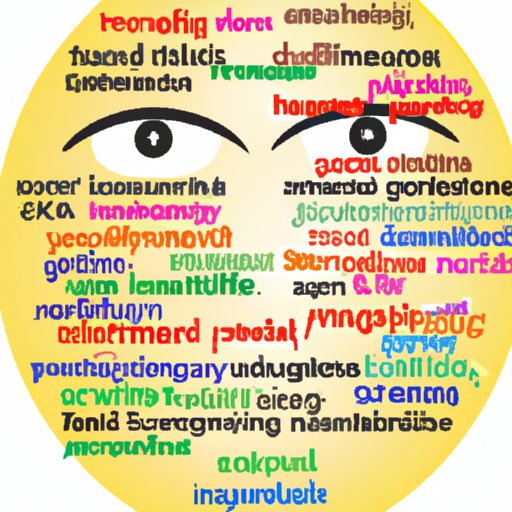Introduction
Describing a face in writing can be a fun challenge. Whether you need to write a character description for a story or are simply trying to describe someone you know, it can be difficult to put into words what makes someone unique. By using strong adjectives and adverbs, evoking emotion, and providing details about facial features, you can create an effective and memorable description of a face.

Use Vivid Adjectives and Adverbs to Describe Facial Features
Adjectives and adverbs are an important part of describing a face. These words can help bring your description to life and make it more vivid and interesting. When selecting adjectives and adverbs, try to find words that will accurately describe the face you are trying to describe without being too obvious. For example, instead of saying “She had big eyes,” you could say “Her saucer-like eyes were framed by long lashes.”
When describing each facial feature, consider using both adjectives and adverbs. For example, when describing a person’s eyes, you could say “Her eyes sparkled mischievously” or “His gaze was piercingly intense.” Here are some examples of adjectives and adverbs you could use to describe various facial features:
- Eyes: sparkling, mischievous, piercing, intense, thoughtful, curious, twinkling
- Nose: small, pointed, upturned, aquiline, prominent
- Mouth: wide, full, curved, pouty, thin-lipped
- Cheeks: rosy, chubby, sunken, angular
- Chin: dimpled, pointed, square, rounded
Describe the Person’s Expressions
A person’s expressions can tell you a lot about them, so it is important to include this in your description. When describing a person’s expressions, you should focus on their eyes, mouth, and posture. Different expressions can convey different emotions, such as sadness, joy, fear, anger, surprise, and confusion. Here are some examples of how to describe different expressions:
- Sadness: Her eyes were downcast and her mouth was downturned in a frown.
- Joy: His eyes lit up and his mouth curved into a wide smile.
- Fear: His eyes widened and his body stiffened in fright.
- Anger: Her jaw clenched and her eyes narrowed in rage.
- Surprise: His eyebrows shot up and his mouth formed an O of surprise.
- Confusion: His head tilted to the side and his eyes squinted in confusion.
Give Details About the Shape of the Face
The shape of a person’s face can also add to your description. Different people have different shaped faces, and this can be used to your advantage when creating a vivid description. Common shapes include round, oval, square, and diamond. Here are some examples of how to describe different shapes:
- Round: His face was round and plump, with soft curves and a dimpled chin.
- Oval: Her face was oval-shaped, with high cheekbones and a pointed chin.
- Square: His face was square, with a broad forehead and a strong jawline.
- Diamond: Her face was diamond-shaped, with a narrow forehead and chin, and high cheekbones.
Describe the Color of the Skin, Hair, Eyes, and Other Facial Features
The color of a person’s skin, hair, eyes, and other facial features can also be included in your description. You can describe the exact color, or you can use more general terms such as “dark,” “light,” or “bright.” Here are some examples of how to describe different colors:
- Skin: Her skin was fair and smooth, with a light golden hue.
- Hair: His hair was dark and wavy, with hints of chestnut brown.
- Eyes: Her eyes were bright blue, like a clear summer sky.
- Lips: His lips were a deep shade of rose.
- Freckles: Her cheeks were dotted with freckles, like stars in the night sky.
Evoke Emotion Through Your Description of the Character’s Face
Your description of a face should evoke emotion in the reader. This can be done by describing the character’s facial features in a way that conveys their personality or feelings. For example, if the character is sad, describe their eyes as being “downcast” and their mouth as having a “downturned frown.” If the character is happy, describe their eyes as “sparkling” and their mouth as “curved into a wide smile.”
You can also evoke emotion by describing the character’s face in a way that is unexpected or surprising. For example, if the character is supposed to be angry, you could describe their eyes as “glistening” or their mouth as “twitching with amusement.” This will leave the reader feeling surprised and intrigued.
Conclusion
Writing a description of a face can be a fun and challenging exercise. To effectively describe a face, use vivid adjectives and adverbs, describe the person’s expressions, give details about the shape of the face, and evoke emotion through your description. With practice, you will be able to create vivid and memorable descriptions of any face.
(Note: Is this article not meeting your expectations? Do you have knowledge or insights to share? Unlock new opportunities and expand your reach by joining our authors team. Click Registration to join us and share your expertise with our readers.)
